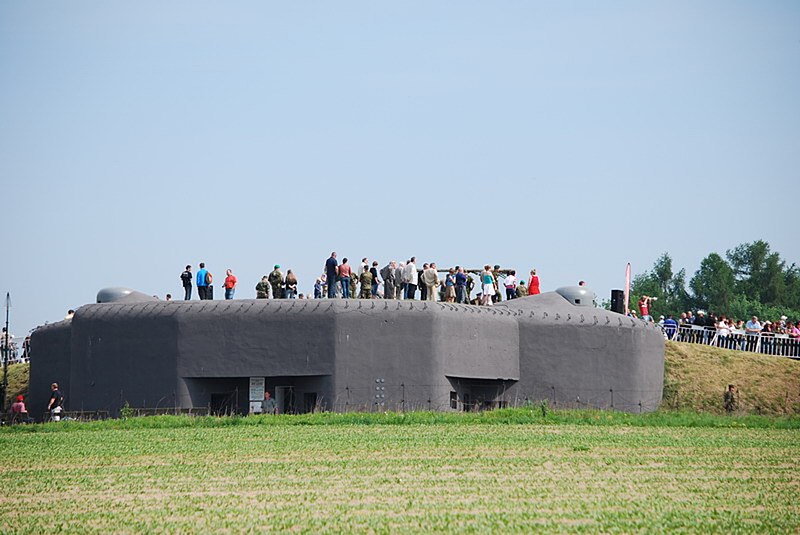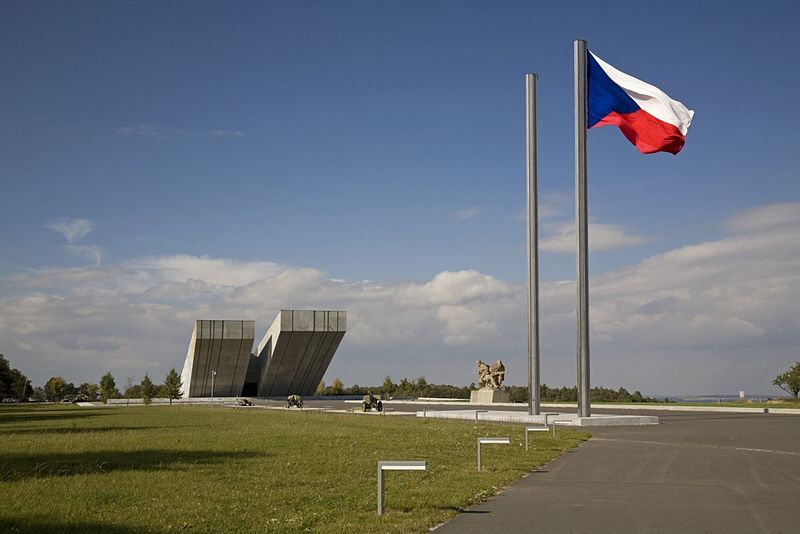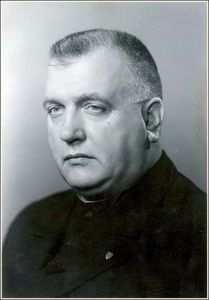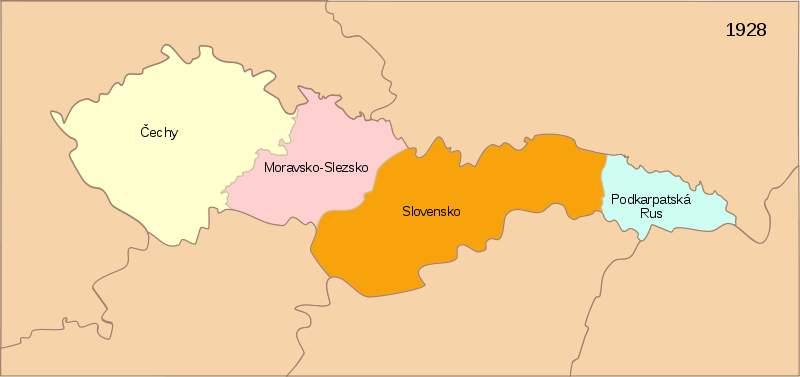In general
The 30’s years of the 20 century (1930-39) was very important period in the Czechoslovakian history. In that time, two actual countries, Czechia (compound by the historical regions- Bohemia, Moravia, Silesia) and Slovakia, and also the historical region Subcarpathian Ruthenia (actually being the part of the state Ukraine) was united to the one state, Czechoslovakia, until 1939. For all Czechs and Slovaks this decade represent the onset of the crisis, severe aggression of Nazism and Fascism against this state.
During that time here changed two different political and governmental organization and presidents. Those political and governmental systems are divided chronologically as the First Republic, Second Republic and the Protectorate of Bohemia and Moravia and Slovak Republic. In the course of the two first political systems, Czechoslovakia was parliamentary democratic at that time.
First Republic, 1918-1938
The First Republic was composed of Bohemia, Moravia, Czech Silesia (all three are historical regions of actual Czechia), Slovakia and Subcarpathian Ruthenia. The independence of Czechoslovakia was proclaimed on October 28, 1918, by the Czechoslovak National Council in Prague. It had two Czech presidents- Tomáš Garrigue Masaryk- the first president of Czechoslovakia (1918-1935) and Edvard Beneš- the second president (1935-1938).
Tomáš Garrigue Masaryk Edvard Beneš
In the autumn of 1929 a crisis broke out which struck the world inclusive of Czechoslovakia, when it started to be recognized in 1930. The state has the economic based on the exportation and it participated on the magnifying of the crisis. Particularly it was observed in the eastern parts of the state (Slovakia and Subcarpathian Ruthenia) because there worked the most people in agriculture, which was affected first.
As the reaction in the political sphere the support of the extremistic political subjects increased. It was: KSČ- Communistic Party of Czechoslovakia, NOF- National Community of Fascists, HSĽS- Hlinka’s Public Party of Slovakia and Vlajka. But one of the biggest dangers represented the radical German political parties (supported of the Germans of the Sudety region- parts of Czechoslovakia with very large German minorities), DNSAP and DNP, which wanted to overwhelm Czechoslovakia, so they were prohibited by the state offices in 1932. In 1933 a law was published forbidding the activity of theese parties, which was originally pointed at DNSAP and DNP but also at the radicaling KSČ, and Slovakian Vlajka, NOF and HSĽS. This law experienced success. But the members of DNSAP and DNP run away to Germany.
The high point of the depression was in the years 1932 and 1933. As the consequence, here the unemployment rose to 1 million, there was misery and hunger. Then started to create a few of the demonstrations and the Ministry of Defense repressed it violently. T.G. Masaryk expressed his discontent with this treatment with citizens. In 1932 in the region Mostecko went off the miners stoppage of 25,000 of miners (it was the biggest stoppage of the Great Depression).
The Great Depression greatly subsided in the second middle of the 30’s (the stimulating of the fabrication, the decrease of the degree of the unemployment, the rise of GHP), but to the end of the existence of the First Czechoslovakian Republic, this land didn’t attain the same economical production as in its beginning.
In the middle of the thirties, then it was very significant to start to protect the state because of the increasing tension of the Germany with its rising of its war potential and starting to possess aggressive position contra all Slavonics (Czechs, Slovaks, Slovenians, Poles, Russians …). The government decided to build the large frontier fortification (for example Darkovičky↓) but the finalization of this project was, with the most optimistic prediction, gauged to 1945.
The 29th September of 1938 was called together the conference of the representatives of the Germany, Great Britain, France, and Italy, which had to decide the destiny of Czechoslovakia, but they had to decide it without any representative of that state. This meeting is called the Munich Agreement. 30th September of 1938, the president Edvard Beneš was forced to agree with the conditions and, factually, it signified the end of the state of Czechs and Slovaks.
In 1938, few months thereafter the death of the first president Tomáš Garrigue Masaryk, Adolf Hitler proclaimed, the Czechoslovakia had to be the first object of the German attack. The pressure forced the Czechoslovakian government to accept the Munich dictate, which caused the disintegration of the state.
Darkovičky complex

It’s Czechoslovak fortification compound in Hlučín-Darkovičky and it is very important because here succeed some of the most important and dramatic events of the Czechoslovakian history. Actually it’s a part of the Silesian Museum since 1992.
The Hlučín-Darkovičky Fortification Complex consists of five structures. The main structure in the Complex is MO-S 19 Alej, which is a two-sided, two-winged, two-floored, independent infantry blockhouse, with two bells and a gun turret, supplemented by the MO-17 Štípky, MO-S 18 Obora and MO-S 20 Orel heavy structures and the embedded, enhanced type-37A 140 Z casemate, known as a řopík.It was built in an exposed location on the then Czechoslovak-German border, in open terrain.
MO-S 19 Alej infantry blockhouse- was designed to house a crew of six.The blockhouse and its main weapons are protected by the extended side walls.Protective ditches located in front of embrasures for main weapons are sometimes labelled ‘diamond ditches’.The gun positions – casemates – contained the blockhouse’s main weapons.
Infantry blockhouse MO-S 17 Štípky-This is a two-sided, two-winged two-floored infantry blockhouse of grade-2 durability with 2 observation zones and a mortar position in a lowered section of the lower floor, with an east-facing embrasure.
Infantry blockhouse MO-S 18 Obora-This is a one-sided, standalone infantry blockhouse built with grade-2 durability. The roof is 2 m thick. The blockhouse was crewed by twenty-four members of Border Regiment 4,based in Hlučín.The blockhouse contains an original, functioning “Royal” pump, a diesel generator, fully-functioning ventilation/filtration system, water tank, accommodation area, munitions stores and a fully-equipped gun position.
Infantry blockhouse MO-S 20 Orel-This is a fortress-type, standalone blockhouse, which was originally intended to form part of the planned U Orla fortress, and is the only part of this fortress that was built. The blockhouse was built in order to fill a gap in the line until the entire fortress was built.
 |
| The Monument of World War II in Hrabyně |
Second Republic, 1938-1939
The official name was Czecho-Slovakian Republic (the hyphen signified the emphasis of the Slovakian bigger "autonomy"). It was composed of the same parts as in the First Republic, but south part of Slovakia was connected to Hungary and some parts of Czechia, called Sudeten, was connected to Germany and Austria. The president was Czech- Emil Hácha (1938-1939).
Slovakia started to have its proper goverment and they named Josef Tiso as their reprsentative. The situation in Slovakia columinaed, when the 9th March of 1939 was declared martial law. J. Tiso, connected with Adolf Hitler, demanded the inmediate separation of Czechia and the day after, they did it. Then arised The Protectorate of Bohemia and Moravia and Slovak Republic.
Protectorate of Bohemia and Moravia and Slovak Republic, 1939-1945
The Protectorate of Bohemia and Silesia and The Slovak Republic
At that time the state Great Depression, which was of the economic origin, caused by the economic crisis of the USA which flare up in 1929, hit Czechoslovakia and in the end of the 30’s the general operation of Czechoslovakia affected the start of the power of Adolf Hitler in the neighboring Germany and also ascended the long-term unemployment. As the consequence of the events in the states in Europe this state was sometimes called the "Island of democracy in Central Europe".
The Slovak Republic (1939-45) had the same ground as today (= 2014) has Slovakia. It had the clerical fascizm as the political ideology and the president was Josef Tiso (1939-45), which was the Roman Catholic and fascistic priest, too.
 |
| Josef Tiso |
Both two terriorial formations ceased to exist with the end of the World War II, in 1945.
Authors of the article: Martin Riedl & Denis Kučera (June, 2014)
The text sources:
http://ksv.upol.cz/txt/DejinyCSR.pdf
http://cs.wikipedia.org/wiki/D%C4%9Bjiny_%C4%8Ceskoslovenska
http://dejepis.info/?t=75
http://referaty-seminarky.cz/predvalecna-30-leta-na-uzemi-ceskoslovenska/
http://cs.wikipedia.org/wiki/%C4%8Ceskoslovensko
http://www.zsletovice.cz/pictures/e-learnig/dejepis/zapisy_hodin/9.rocnik/6ceskoslovensko_ve_30_letech.pdf
http://en.wikipedia.org/wiki/Munich_Agreement
http://cs.wikipedia.org/wiki/Slovensk%C3%BD_%C5%A1t%C3%A1t
Images:
http://commons.wikimedia.org/wiki/File:Czechoslovakia01.png
http://commons.wikimedia.org/wiki/File:P%C4%9Bchotn%C3%AD_srub_K-S_14_u_Prost%C5%99edn%C3%AD_Lipky_1938.jpg
http://commons.wikimedia.org/wiki/File:Masaryk_-_detail.png
http://commons.wikimedia.org/wiki/%C4%8Ceskoslovensko#mediaviewer/File:Flag_of_Czechoslovakia.svg
http://commons.wikimedia.org/wiki/File:Tom%C3%A1%C5%A1_Garrigue_Masaryk_1925.PNG
http://cs.wikipedia.org/wiki/Josef_Tiso
http://commons.wikimedia.org/wiki/File:Edvard_Bene%C5%A1.jpg
http://commons.wikimedia.org/wiki/File:Prvn%C3%AD_%C4%8Ceskoslovensk%C3%A1_republika.SVG
http://commons.wikimedia.org/wiki/File:Are%C3%A1l_%C4%8Ds._opevn%C4%9Bn%C3%AD_v_Darkovi%C4%8Dk%C3%A1ch.jpg
http://www.valka.host.sk/obrazky/clanky/protektorat.jpg
The backround music:
http://www.melodymakers.cz/prehled?bio_tan=2




